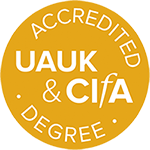Current filters applied:
- (-) Remove Europe filter Europe
- (-) Remove Current Projects filter Current Projects
Displaying 16 projects
At the intersection among the arts, science, and technology, printing is widely recognised as the invention of the millennium. However, and in spite of a resurgence of traditional typographic methods among artists and craftspeople, letterpress equipment and technology face an uncertain future...
The above photo shows: A left lateral aspect of a cranium from Catignano (a Middle Neolithic village in Abruzzo), showing two healing trepanations on the left parietal bone and healed fracture on the left frontal and parietal bones of a 40-50 year old female How did politics and inequality work in...
The aim of the ERC project Beasts to Craft (B2C) is to document the biological and craft records in parchment in order to reveal the entangled histories of improvement and parchment production in Europe from 500-1900 AD.
The project will research how archaeological and palaeoecological narratives of past land management and climate change adaptation can shape sustainable farming, regenerative agriculture, and rewilding strategies in the Cambridgeshire Fenlands. The nationally important agricultural area is...
In Western Europe the main use for artificial monuments out of stone, wood or earthy materials extends from the Late Neolithic to Early Bronze Age (4th and 3rd millennium BCE). This unique period of landscape adaptation has a lasting, visible imprint on the present. However, as monuments are by...
Our knowledge of human evolution is limited by several factors. One is tightly linked to the nature of the fossil record, as bones of our extinct human relatives and other primate species rarely appear in archaeological and paleontological sites, and when they do, they very commonly appear in an...
This archaeology-led initiative focuses on the East Anglian Fens, an extraordinary landscape where exceptional preservation of organic artefacts and environmental evidence gives unparalleled insights into the last 5,000 years of communities, resources and habitats. The Fens are the richest and most...
This project takes as its focus the 1937 aerial bombardment of Gernika as a political and artistic event rooted in—and in ongoing dialogue with—colonial violence in the Middle East & North Africa. It connects the 1920s aerial bombardment of civilians in colonial Iraq, Syria, Afghanistan, and...
Northern Bosnia is a key location in which to investigate human-environment interactions in the Late Pleistocene /Middle-Upper Palaeolithic. Our research aims to evaluate hominan resource networks and investigate palaeoenvironmental conditions during this period, and address the following...
The Must Farm project is the first landscape scale archaeological investigation of deep Fenland, with its complex geological history.
Stone tool artefacts represent the only continuous material record from early hominins across a period of three million years. Lithics provide information about early human technological adaptations and innovations, and in turn, understanding these technologies allows insights into early human...
How did the biomechanics and ergonomics of the human hand influence the use and production of Palaeolithic stone tools? Traditionally, stone tools have been analyzed for their morphological properties and technological characteristics to infer the cognitive and social evolution of early hominins...
Fordwich has been revealed to be the oldest directly-dated Acheulean occurrence in the United Kingdom, with artefacts dating from 560,000 to 620,000 years ago (MIS 15). This makes it the second oldest Acheulean site in north-west Europe, and the oldest to display a known handaxe assemblage...
This five-year project funded by the International Holocaust Remembrance Alliance seeks to write European heritage guidelines for Holocaust and Roma genocide sites in order to safeguard them for the future.
The project Science @ Tarquinia aims to provide the complementary scientific support for the long-standing study of the ancient Etruscan city of Tarquinia by the University of Milan. This Unesco World Heritage site is well known for its magnificent painted tombs, its city walls, the Temple of Ara...
A Bronze Age fortified tell settlement on the right bank of the river Danube 30km south of Budapest.


